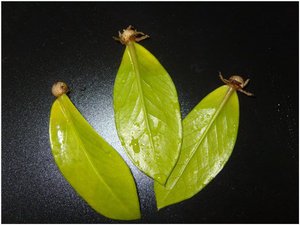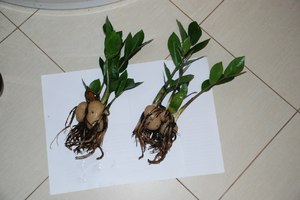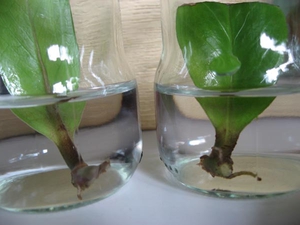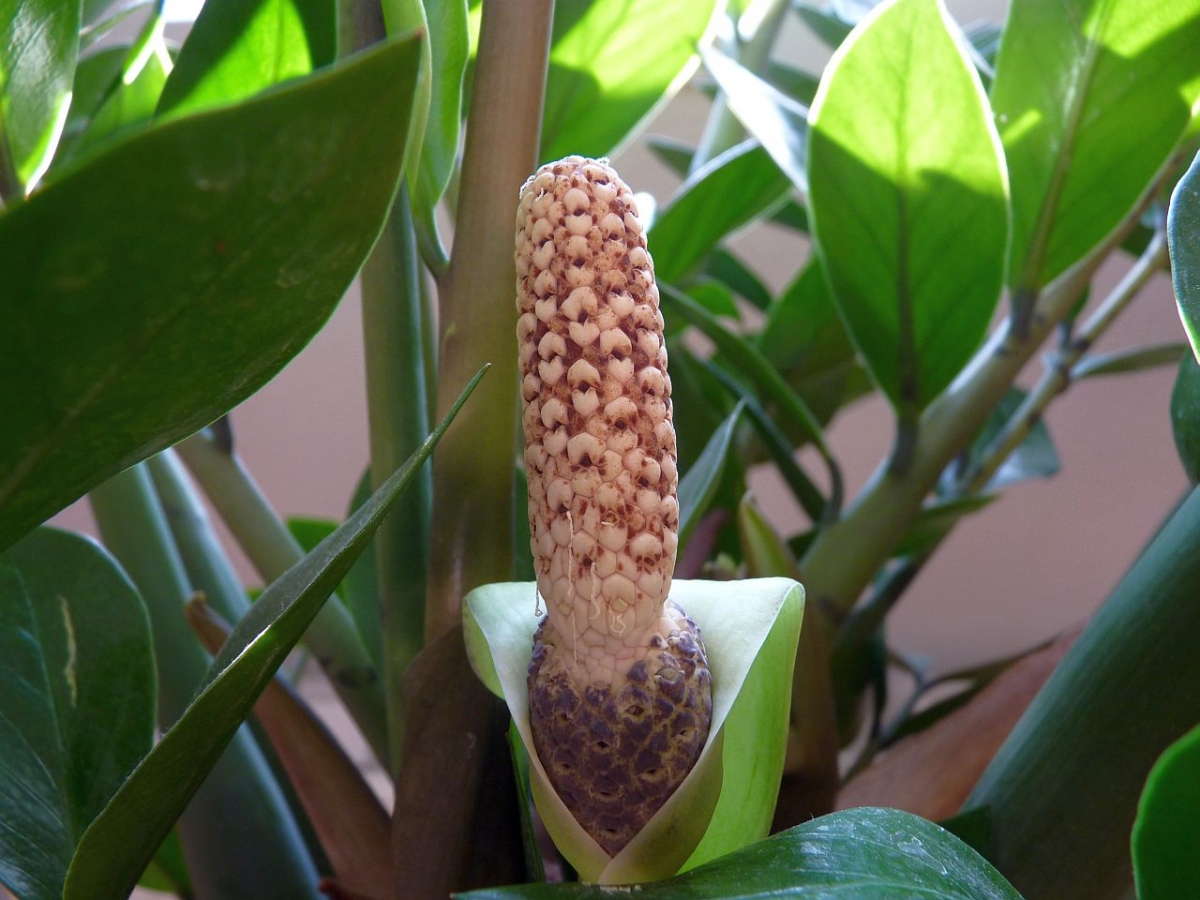 Every year, domestic flower growers acquire more and more new indoor plants. Zamioculcas, which won love with its graceful appearance, is no longer a rarity. The homeland of this plant is located on the rocky mountain plateaus of East Africa and the island of Madagascar.
Every year, domestic flower growers acquire more and more new indoor plants. Zamioculcas, which won love with its graceful appearance, is no longer a rarity. The homeland of this plant is located on the rocky mountain plateaus of East Africa and the island of Madagascar.
This plant looks like a rosette from which complex long leaves of a dark green color with a glossy effect originate. On each side of the rachis, which is the central part of the leaf plate, turning into the petiole, there are miniature fleshy leaves, decorated with a pointed tip. Adult specimens look more impressive, in which leaves can reach 1-1.5 m.
If you create favorable conditions for zamiokulkas, then every season it will delight the owner with abundant flowering. Despite the fact that the decorative properties are more pronounced in the leaves than in the flowers, most specialists in the field of floristry also enjoy the flowering of their pets. Zamiokulkas flowers are elegantly hidden in the axils of the leaves, which form complex inflorescences: they are presented in the form of a combination of a creamy cob and a greenish stipule.
Everyone who has seen an adult zamioculcas at least once noted it decorative properties... However, this plant is interesting not only for the attractiveness of its succulent leaves. In connection with it, mention should be made of the legend according to which this flower can bring prosperity and increase the financial condition of the owner. This belief led to the emergence of another name for zamiokulkas - "dollar tree". Therefore, this flower can often be found in bank premises. However, the majority explains the similar name of zamiokulkas by its unusually high cost.
Believe it or not this legend is everyone's business. What you can be sure of is that by bringing zamiokulkas to your home, you will receive a spectacular decoration, in the process of growing which you will not need to spend a lot of time and effort. However, if you want to start breeding zamiokulkas, then it will not hurt you to first get acquainted with the main features of this plant.
Content
Zamiokulkas breeding methods at home
To get new bushes of zamiokulkas, you must first of all decide on a suitable breeding method.
Dividing an adult plant
 If you have a planned transplant of this indoor plant ahead of you, then you can use the opportunity presented to you and divide it into separate fragments with a growth point to get new bushes. Reproduction of zamiokulkas tuber seems to be a fairly simple event. All that needs to be done is split into separate parts mother plant.
If you have a planned transplant of this indoor plant ahead of you, then you can use the opportunity presented to you and divide it into separate fragments with a growth point to get new bushes. Reproduction of zamiokulkas tuber seems to be a fairly simple event. All that needs to be done is split into separate parts mother plant.
However, here you need to be as careful as possible, trying not to injure the root tuber. Having finished the operation of dividing the plant, the resulting fragments must be placed in the air so that they can dry out. In this case, the sections must be treated with charcoal or activated carbon.
For transplanting, use containers filled with light soil. It can also be a universal soil, in which it will not hurt to add a little vermiculite, because it will help give the substrate a looser structure. Within three days after planting, observe the "dry" mode, after which they can be sprayed with standing water from a sprayer.
On the benefits of using vermiculite for transplanting indoor plants and in gardening:https://flowers.desigusxpro.com/en/uhod-za-rasteniyami/udobreniya/chto-takoe-vermikulit-i-kak-ego-primenyat-dlya-rasteniy.html
Sheet
This breeding method involves carrying out a specific set of actions with a leaf borrowed from an adult plant.
- first you need to cut it off, and then let it dry for several hours;
- after that, the cut site must be treated with charcoal or root growth stimulant "Kornevin". This completes the preparatory operations, and the leaf can be transplanted into the prepared universal soil. It can also be replaced with a soil mixture for succulent plants;
- three days after planting, the soil can be sprayed, without forgetting to moisten the leaf.
Next, you need to be patient, since the formation of roots on a tuber is a rather long process, which will take about 2-3 months. Zamioculcas is one of those rare plants that grow extremely slowly. In order to be able to form new leaves, you will have to wait about 6-7 months.
Cuttings
 Among the available methods for propagating zamiokulkas at home, cuttings are the most preferable. As planting material shoots are usedborrowed from an adult specimen of zamiokulkas. Leaf propagation does not allow to prepare so many cuttings, since one adult leaf from the mother plant is used here.
Among the available methods for propagating zamiokulkas at home, cuttings are the most preferable. As planting material shoots are usedborrowed from an adult specimen of zamiokulkas. Leaf propagation does not allow to prepare so many cuttings, since one adult leaf from the mother plant is used here.
It is not recommended to propagate zamioculcas with young leaves, because due to underdevelopment, as well as the fact that they have not yet formed a full-fledged leaf plate, the chances of success are extremely low here. Young leaves contain low in nutrients, without which it is impossible to get full-fledged plants from cuttings.
- for harvesting cuttings, a well-developed middle-aged leaf on an adult plant is used;
- then it must be divided into separate cuttings, so that each has two opposite leaves;
- a cutting cut from the top of the leaf may have three leaves. After cutting, the cuttings must be allowed to lie in the air for a couple of hours so that the windy layer appears. You should not rush to transplant the cuttings directly into the universal soil, because due to high humidity they can rot and die;
- the ends of the branches must be treated with activated charcoal or another root growth stimulator - Zircon or Kornevin. As a result of this operation, they will be protected from disease;
- for planting cuttings at home, you should use a universal light soil, in which you must first add vermiculite. This substance will help loosen the potting mix. In order for the branches to take root as soon as possible, they can be transferred to a microsteam, which must be closed with glass or a plastic cap. Given that the propagation of zamiokulkas by cuttings rarely ends in failure, most gardeners often transplant them directly into plastic glasses, not transferring them to a greenhouse;
- the first watering of the cuttings is carried out only after two to three days. This is done by spraying the soil using a sprayer. In the next 1-2 months, large nodules with roots will begin to form in the soil on the branches. For the next 5-6 months, the florist will have to stock up on great patience, since it is after this time that the first leaves may appear.
Leaves
 You can get new bushes of zamiokulkas at home not only from a branch, but also with the help of separate small leavestaken from a large leaf of a plant. In this case, it is necessary to prepare leaves that are prepared for rooting from a leaf. But first they are placed in the air for a couple of hours so that the cut can dry out. The lower part of the leaf must be treated with drugs that stimulate the formation of roots.
You can get new bushes of zamiokulkas at home not only from a branch, but also with the help of separate small leavestaken from a large leaf of a plant. In this case, it is necessary to prepare leaves that are prepared for rooting from a leaf. But first they are placed in the air for a couple of hours so that the cut can dry out. The lower part of the leaf must be treated with drugs that stimulate the formation of roots.
In addition to all available activated or charcoal, you can use modern drugs - Kornevin, Zircon... When using the latter, you can prepare a mixture by adding coal to them.
How to use the biostimulator Kornevin correctly:https://flowers.desigusxpro.com/en/uhod-za-rasteniyami/udobreniya/instrukciya-po-primeneniyu-biostimulyatora-kornevin-dlya-rasteniy.html
This completes all the main preparatory activities with the leaves. You can proceed to rooting. To do this, you need to place the lower part of the leaf in a moist substrate prepared on the basis of sand and peat. Glass must be laid on top of the container, thereby creating the effect of a microsteam. Before emergence, it is necessary to periodically ventilate.
It is also possible to propagate zamioculcas by planting leaves without a greenhouse. In this case, universal soil or soil prepared for growing succulents can be used as a substrate for rooting the leaves. After two to three days from the moment of planting, the leaves and soil are watered by spraying from a sprayer. And a month later, you can observe the first changes: where the callus is located, which is understood as the leaf tissue that occurs at the cut site, small tubers will form... Subsequently, they will actively grow, over time, white roots will appear on them.
The size of the planting material used for propagating zamiokulkas vegetatively directly affects how long it takes to wait for the formation of new leaves in the plant. Therefore, it is recommended to use as large copies as possible. If you use small leaves, then there are times when new leaves are formed only after a year.
Reproduction in water
 In addition to the above methods, a new zamiokulkas plant can be obtained by placing a leaf in water, in which the root system will form. But first, the place of the leaf cut must be treated with root-forming stimulants. These can be drugs such as:
In addition to the above methods, a new zamiokulkas plant can be obtained by placing a leaf in water, in which the root system will form. But first, the place of the leaf cut must be treated with root-forming stimulants. These can be drugs such as:
- Kornevin;
- Zircon;
- Heteroauxin.
They will help speed up the rooting process... However, if we rely on the experience of flower growers, then the most preferred breeding option is rooting of zamiokulkas in the ground.
What is Zircon and how to use it correctly so as not to harm the plant:https://flowers.desigusxpro.com/en/uhod-za-rasteniyami/udobreniya/preparat-cirkon-instrukciya-po-primeneniyu.html
Conclusion
Zamioculcas can diversify the green corner in the apartment of any sophisticated florist. If desired, he can acquire several representatives of this plant, for which he only needs to know how to propagate zamiokulkas, and choose the appropriate method. Undoubtedly, the simplest and most successful is propagation by cuttings, which in most cases guarantees the success of this event. However, flower lovers immediately need to be patient, since zamioculcas belongs to the group of slow-growing plants, therefore, it will take an average of six months to wait for the formation of the first leaves.


